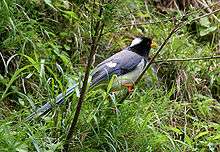Yellow-billed blue magpie
| Yellow-billed blue magpie | |
|---|---|
 | |
| From Chopta, Uttarakhand, India | |
| Scientific classification | |
| Kingdom: | Animalia |
| Phylum: | Chordata |
| Class: | Aves |
| Order: | Passeriformes |
| Family: | Corvidae |
| Genus: | Urocissa |
| Species: | U. flavirostris |
| Binomial name | |
| Urocissa flavirostris (Blyth, 1846) | |
The yellow-billed blue magpie or gold-billed magpie (Urocissa flavirostris) is a passerine bird in the crow and jay family, Corvidae. It forms a superspecies with the Taiwan blue magpie and the red-billed blue magpie. The species ranges across the northern parts of the Indian Subcontinent including the lower Himalayas, with a disjunct population in Vietnam.
Description
Length 66 cm (26 in), including tail of about 46 cm (18 in). Sexes alike. Head, neck, and breast black, with a white patch on the nape; remainder of lower plumage white, faintly tinged with lilac; whole upper plumage purplish-blue, brighter on the wings and tail; flight-feathers tipped with white, the outermost edged with the same; tail long and graduated, the feathers blue, broadly tipped with white, all except the very long central pair having a band of black in front of the white
Distribution
The yellow-billed blue magpie is found throughout the Himalayas from Hazara to the Brahmaputra. It is divided into two races. Of these, U. f. cucullata is the better known and is found from the Western boundary of the range to Western Nepal, being a common species about most of the hill stations of the Western Himalayas, breeding in a zone from 1,500 to 3,000 m (4,900 to 9,800 ft). The typical form is found from Eastern Nepal eastwards and differs in that the under parts have a darker lilac tinge; its zone is slightly higher than that of the Western form, as it seldom occurs as low as 1,830 m (6,000 ft). A resident species, but during the winter months it usually deserts the higher parts of its summer zone. From Simla eastwards, the closely allied red-billed blue magpie (Urocissa erythroryncha) is often found in the same areas as the yellow-billed species; it is particularly common about Mussoorie, Tehri-Garhwal, -Kumaon, and in Nepal, and may be easily distinguished by its red beak and the greater extent of the white nape-patch.
Behaviour
The blue magpies are, as may be judged from their handsome tails, essentially arboreal birds; though, while they are most usually to be met with in heavy jungle areas, they also venture out into the trees amongst cultivation, and at times on to bare mountain sides at high elevations. They frequently feed on the ground and then adopt a curious hopping gait, with the tail held high to prevent it coming into contact with the ground. They live in parties of seven or eight birds and are very partial to particular localities, so that once a party has taken up its abode in any particular nullah or patch of forest it will generally be found there. They are very active, flying incessantly from bough to bough and not hesitating to launch high into the air when flying from ridge to ridge; a party of these bird crossing a nullah out of gunshot above one's head is a curious sight, with their long tails waving in the air and the light shining through the feathers. The flight is rather slow, laboured, and undulating once the bird comes into the open. The food consists of small mammals, the eggs and young of other birds, insects, and wild fruits and berries of various kinds. This bird is very noisy; the ordinary call is harsh and grating, but it has a wide variety of notes, some of which are melodious enough.
Nesting
The nest is built in a fork of a tree, usually of moderate size but with dense foliage, and is difficult to find. It is a rather large and roughly constructed cup of sticks with a lining of fine grass, roots and fibres. The clutch consists of three or four eggs. The base-colour varies from a pale, dingy yellowish-stone colour to a darkish rather reddish-stone colour, and there is very occasionally a faint greenish tinge. The markings consist of small specks, blotches, streaks, and mottlings of various shades of brown, sienna 1 or purple, and they generally tend to collect in a cap or zone about the broad end of the egg.
 Yellow-billed blue magpie at Kullu - Manali District of Himachal Pradesh, India
Yellow-billed blue magpie at Kullu - Manali District of Himachal Pradesh, India at Kullu
at Kullu at Bhutan
at Bhutan
 at Kullu
at Kullu at Kullu
at Kullu
| The yellow-billed blue magpie or gold-billed magpie in natural habitat at Lohna, Palampur | ||||||
|---|---|---|---|---|---|---|
|
References
- ↑ BirdLife International (2012). "Urocissa flavirostris". IUCN Red List of Threatened Species. Version 2013.2. International Union for Conservation of Nature. Retrieved 26 November 2013.


.jpg)
